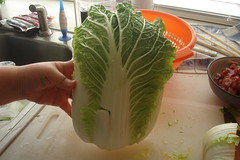Here's the problem--just one of these light bulbs easily cost upwards of $10-13. It's a clever way for Aerogarden to get themselves a regular source of revenue, sort of like the way Gillette never made money on its razors but on the razor blades. But for someone like me who wanted to get into indoor gardening partially to save money, it really doesn't make sense for me to be raving about how I save money by not buying fresh herbs, but end up paying triple the amount I would have paid in electricity and replacement bulbs.
Now for years I've been fastidiously buying from the Aerogarden Store, but when one of my grow lights decided to fail lately, I decided to bite the bullet and try one of these adapters I've been seeing on eBay. They look like this:
Here's how it works. You take a regular CFL or LED light bulb, the same kind you use around the house, and screw it into the adapter.
Then, you plug the adapter right into the Aerogarden. Note that certain light bulbs are going to be too big to fit, but the ones I happened to have lying around fit perfectly.
For your reference, Aerogarden replacement lights typically produce 1450 lumens of light and use 26 watts, so you'll want your CFL or LED bulb to output about the same.
One thing to keep in mind is that depending on what model of Aerogarden you have, you'll need to choose between two types of light bulb sockets.
Most Aerogardens that have three lights except for the Ultra, including the original Aerogarden Extra (not the "Miracle Gro" branded Aerogarden Extra), Aerogarden Extra Elite, VeggiePro, Elite+, Pro200, Deluxe, and Deluxe Upgrade Kit) use a light bulb that has more of a flat end, with two metal prongs coming out of it parallel to the shape of the light (model #100633).
 |
| Aerogarden Light 100633 |
 |
| Aerogarden Light 1000629 or 100340 |
Obviously, Aerogarden doesn't sell these on their store, but a good place to go is eBay. Just search for "aerogarden adapter" and you'll find sellers selling them for about $10-14 each; the price has gone up a little since I first wrote this post, but it's still a bargain considering the savings you'll get over time. As with everything on eBay, make sure to check that the seller has a good history and great reviews, and make doubly sure that you have the adapter for the right model. The seller I used, whom I was very happy with, doesn't seem to carry them anymore, but there are certainly plenty of others that do. Just make sure you're buying the adapter that lets you use regular light bulbs in the Aerogarden, not the adapter that lets you use Aerogarden bulbs in a regular light socket.
and you'll find sellers selling them for about $10-14 each; the price has gone up a little since I first wrote this post, but it's still a bargain considering the savings you'll get over time. As with everything on eBay, make sure to check that the seller has a good history and great reviews, and make doubly sure that you have the adapter for the right model. The seller I used, whom I was very happy with, doesn't seem to carry them anymore, but there are certainly plenty of others that do. Just make sure you're buying the adapter that lets you use regular light bulbs in the Aerogarden, not the adapter that lets you use Aerogarden bulbs in a regular light socket.
Now obviously this isn't sanctioned by Aerogarden, so chances are if you have a warranty on your product using one of these would probably invalidate it if they were to find out. On the other hand, if you're like me and have already sent hundreds of dollars of your hard-earned money to them, these little adapters are a great way to keep your gardens running.
Now obviously this isn't sanctioned by Aerogarden, so chances are if you have a warranty on your product using one of these would probably invalidate it if they were to find out. On the other hand, if you're like me and have already sent hundreds of dollars of your hard-earned money to them, these little adapters are a great way to keep your gardens running.













































